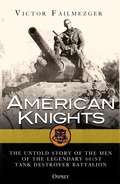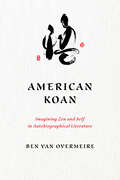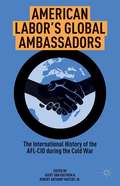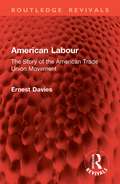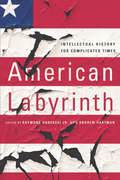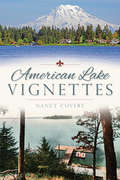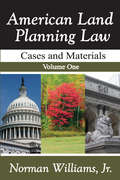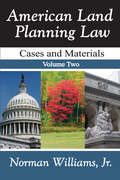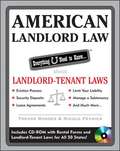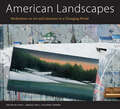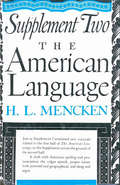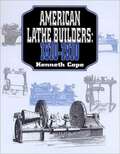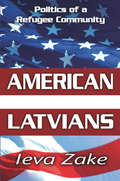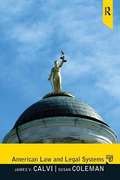- Table View
- List View
American Klezmer: Its Roots and Offshoots
by Mark SlobinKlezmer,the Yiddish word for a folk instrumental musician, today flourishes in the United States and abroad in the world music and accompany Jewish celebrations. The essays collected in this volume investigate American klezmer: its roots, its evolution, and its spirited revitalization. The contributors offer a wide range of perspectives on the musical, social, and cultural history of klezmer in American life.
American Knights
by Victor FailmezgerAn unmissable white-knuckle ride from the Kasserine pass to Anzio, Operation Dragoon to the final attacks on the Third Reich, this is the gripping story of the men and machines that took on Nazi Germany's best. This book not only reveals the technical details and origins of the 601st Tank Destroyer Battalion, it places the reader on the front lines of the European war. As the war swung in the favor of the Allies, it became clear that no final defeat of the Third Reich would be possible until the armored monsters of the Panzerwaffe were defeated. But who would, or even could, take on the mighty Tigers and Panthers, just a handful of whom could stop entire formations in their tracks? The answer lay with the formation of a new type of unit, the Tank Destroyer Batallion. This is the story of the men and machines who made up the very first Tank Destroyer Batallion, the 601st, from their unique training and formation, to the final, desperate battles in the heart of Nazi Germany. Packed with rare material, letters, diaries and unpupublished photographs, this is an intense and intimate chronicle of the men who fought the Panzers in an astonishing 10 campaigns and 546 days of lethal combat. Re-live the excitement and terror of battling the best the Wehrmacht and SS had to offer, in every major campaign in the West.
American Koan: Imagining Zen and Self in Autobiographical Literature (Studies in Religion and Culture)
by Ben Van OvermeireHow American Buddhists use Zen riddles to imagine who they are The koan is one of the most recognizable East-Asian spiritual exercises—a thought experiment in the form of a riddle or puzzle that Zen Buddhists employ to become enlightened. Well-known examples include the question &“What is the sound of one hand clapping?,&” "Does a dog have Buddha-nature?," and the injunction &“If you meet the Buddha on the road, kill him.&” In American Koan, Ben Van Overmeire examines the literary function of these ancient dialogues in autobiographies of modern Western writers such as Natalie Goldberg, Peter Matthiessen, Philip Kapleau, Ruth Ozeki, and others. Through his attentive analyses of these authors, Van Overmeire unveils the rich world of American Zen literature and delves into the meaning of success and failure in Zen; how women find a place in this patriarchal tradition; how to combine Zen insight with compassion; and the illusory nature of linear time. Critical yet empathetic, this is a scintillating study of how Americans become Buddhas.
American Kompromat: How the KGB Cultivated Donald Trump, and Related Tales of Sex, Greed, Power, and Treachery
by Craig UngerKompromat n.—Russian for "compromising information" This is a story of dirty secrets, and the most powerful people in the world. Craig Unger’s new book, American Kompromat, tells of the spies and salacious events underpinning men’s reputations and riches. It tells how a relatively insignificant targeting operation by the KGB’s New York rezidentura (New York Station) more than forty years ago—an attempt to recruit an influential businessman as a new asset—triggered a sequence of intelligence protocols that morphed into the greatest intelligence bonanza in history. And it tells of a coterie of associates, reaching all the way into the office of the Attorney General, who stood to advance power, and themselves. <P><P>Based on extensive, exclusive interviews with dozens of high-level sources—Soviets who resigned from the KGB and moved to the United States, former officers in the CIA, FBI counterintelligence agents, lawyers at white-shoe Washington firms--and analysis of thousands of pages of FBI investigations, police investigations, and news articles in English, Russian, and Ukrainian, American Kompromat shows that something much more sinister and important has been taking place than the public could ever imagine: namely, that from Donald Trump to Jeffrey Epstein, kompromat operations documented the darkest secrets of the most powerful people in the world and transformed them into potent weapons. <P><P> Was Donald Trump a Russian asset? Just how compromised was he? And how could such an audacious feat have been accomplished? American Kompromat is situated in the ongoing context of the Trump-Russia scandal and the new era of hybrid warfare, kleptocrats, and authoritarian right-wing populism it helped accelerate. To answer these questions and more, Craig Unger reports, is to understand kompromat—operations that amassed compromising information on the richest and most powerful men on earth, and that leveraged power by appealing to what is for some the most prized possession of all: their vanity. <P><P> <b>A New York Times Bestseller</b>
American Labor and American Democracy
by William WallingIn American Labor and American Democracy, William English Walling drew on his close association with Samuel Gompers and other leaders of the American Federation of Labor (AFL) to write the authoritative history of the labor movement in the first quarter of the twentieth century.Walling's position was that twentieth-century American democracy was not stagnant. It was a living, developing trend in society, with the AFL as its most progressive force. There could be no passive acceptance of American institutions as they stood: government in the twentieth century would need to develop into a medium for attaining social ideals and needs beyond individual realization. The aim of American labor was a pluralistic economic democracy in which government and industry would be guided by economic organizations representing not only labor, but every essential social group. Richard Schneirov, in his introduction to this new edition of a classic book, paints a rich and detailed picture of Walling's political and intellectual journey, and of his many contributions to the synthesis of democratic and socialist principles. American Labor and American Democracy is an important work that will help reevaluate our understanding of labor and working-class history, establish a new perspective on today's labor movement, and shed light on the relationship of labor to socialism, capitalism, democracy, and social movements; the nature of the large business corporation; and the relationship of special interest groups to democracy.William English Walling (1877-1936) was a social reform activist who helped found the National Women's Trade Union League in 1903 and the National Association for the Advancement of Colored People in 1909. He authored several influential works, including Socialism as it Is: A Survey of the World-Wide Revolutionary Movement, The Larger Aspects of Socialism, Progessivism and After, and The Socialists and the War. Richard Schneirov is professor of history at Indiana State University, and has also taught at The Ohio State University and the Institut f(3)r England und Amerikastudien at the University of Frankfurt, Germany. He is the author of Labor and Urban Politics: Class Conflict and the Origins of Modern Liberalism in Chicago, 1864-97, which was awarded the Urban History Association's prize for best urban history in North America for 1998 and co-edited The Pullman Strike and the Crisis of the 1890s.
American Labor and Economic Citizenship
by Mark HendricksonOnce viewed as a distinct era characterized by intense bigotry, nostalgia for simpler times, and a revulsion against active government, the 1920s have been rediscovered by historians in recent decades as a time when Herbert Hoover and his allies worked to significantly reform economic policy. In American Labor and Economic Citizenship, Mark Hendrickson both augments and amends this view by studying the origins and development of New Era policy expertise and knowledge. Policy-oriented social scientists in government, trade union, academic, and nonprofit agencies showed how methods for achieving stable economic growth through increased productivity could both defang the dreaded business cycle and defuse the pattern of hostile class relations that Gilded Age depressions had helped to set as an American system of industrial relations. Linked by emerging institutions such as the Social Science Research Council, the National Urban League, and the Women's Bureau, social investigators attacked rampant sexual and racial discrimination, often justified by fallacious biological arguments, that denied female and minority workers full economic citizenship in the workplace and the polity. These scholars demonstrated that these practices not only limited productivity and undercut expanded consumption, but also belied the claims for fairness that must buttress policy visions in a democracy.
American Labor, Congress, and the Welfare State, 1935–2010
by Tracy RoofDespite achieving monumental reforms in the United States such as the eight-hour workday, a federal minimum wage, and workplace health and safety laws, organized labor’s record on much of its agenda has been mixed. Tracy Roof’s sweeping examination of labor unions and the American legislative process explains how this came to be and what it means for American workers.Tracing a 75-year arc in labor movement history, Roof discusses the complex interplay between unions and Congress, showing the effects of each on the other, how the relationship has evolved, and the resulting political outcomes. She analyzes labor’s success at passing legislation and pushing political reform in the face of legislative institutional barriers such as the Senate filibuster and an entrenched and powerful committee structure, looks at the roots and impact of the interdependent relationship between the Democratic Party and the labor movement, and assesses labor’s prospects for future progress in creating a comprehensive welfare state. Roof’s original investigation details the history, actions, and consequences of major policy battles over areas such as labor law reform and health care policy. In the process, she brings to light practical and existential questions for labor leaders, scholars, and policy makers.Although American labor remains a force within the political process, decades of steadily declining membership and hostile political forces pose real threats to the movement. Roof’s shrewd exploration of unions, Congress, and the political process challenges conventional explanations for organized labor’s political failings.
American Labor, Congress, and the Welfare State, 1935–2010
by Tracy RoofA study of the relationship between the U.S. Congress and the American labor movement over the course of a 75-year period.Despite achieving monumental reforms in the United States such as the eight-hour workday, a federal minimum wage, and workplace health and safety laws, organized labor’s record on much of its agenda has been mixed. Tracy Roof’s sweeping examination of labor unions and the American legislative process explains how this came to be and what it means for American workers.Tracing a 75-year arc in labor movement history, Roof discusses the complex interplay between unions and Congress, showing the effects of each on the other, how the relationship has evolved, and the resulting political outcomes. She analyzes labor’s success at passing legislation and pushing political reform in the face of legislative institutional barriers such as the Senate filibuster and an entrenched and powerful committee structure, looks at the roots and impact of the interdependent relationship between the Democratic Party and the labor movement, and assesses labor's prospects for future progress in creating a comprehensive welfare state. Roof’s original investigation details the history, actions, and consequences of major policy battles over areas such as labor law reform and health care policy. In the process, she brings to light practical and existential questions for labor leaders, scholars, and policy makers.Although American labor remains a force within the political process, decades of steadily declining membership and hostile political forces pose real threats to the movement. Roof’s shrewd exploration of unions, Congress, and the political process challenges conventional explanations for organized labor’s political failings.
American Labor’s Global Ambassadors
by Jr. Robert Anthony Waters Geert Van Goethem Marcel Van Der L IndenFollowing World War II, the AFL-CIO pursued an ambitious international agenda. To its leaders, the imperatives of saving Western Europe from Stalinism, rolling back Soviet gains in Eastern Europe, containing Communism around the world, throwing off the shackles of colonialism, and overcoming "uneven development" justified extraordinary measures. They sought to protect international labor while fostering American-style "business unionism," which used collective bargaining and strikes to capture a greater share of the capitalist system's economic pie. At the same time, they believed that thwarting Communist designs on local organizations was a prerequisite to cultivating free labor movements and creating prosperity for the world's workers - and battling Communism often meant working in conjunction with the US government, including even the Central Intelligence Agency. This sweeping state-of-the-field collection brings together contributions from leading diplomatic, labor, and transnational historians to explore and assess the AFL-CIO's successes, challenges, and inevitable compromises as it pursued these varied initiatives during the Cold War era.
American Labour's Cold War Abroad: From Deep Freeze to Détente, 1945-1970
by Anthony CarewDuring the Cold War, American labour organizations were at the centre of the battle for the hearts and minds of working people. At a time when trade unions were a substantial force in both American and European politics, the fiercely anti-communist American Federation of Labor–Congress of Industrial Organizations (AFL–CIO), set a strong example for labour organizations overseas. The AFL–CIO cooperated closely with the US government on foreign policy and enjoyed an intimate, if sometimes strained, relationship with the CIA. The activities of its international staff, and especially the often secretive work of Jay Lovestone and Irving Brown—whose biographies read like characters plucked from a Le Carré novel—exerted a major influence on relationships in Europe and beyond.Having mastered the enormous volume of correspondence and other records generated by staffers Lovestone and Brown, Carew presents a lively and clear account of what has largely been an unknown dimension of the Cold War. In impressive detail, Carew maps the international programs of the AFL–CIO during the Cold War and its relations with labour organizations abroad, in addition to providing a summary of the labour situation of a dozen or more countries including Finland, France, Italy, Germany, Japan, Greece, and India. American Labour’s Cold War Abroad reveals how the Cold War compelled trade unionists to reflect on the role of unions in a free society. Yet there was to be no meeting of minds on this, and at the end of the 1960s the AFL–CIO broke with the mainstream of the international labour movement to pursue its own crusade against communism.
American Labour: The Story of the American Trade Union Movement (Routledge Revivals)
by Ernest DaviesFirst Published in 1943, American Labour presents a comprehensive story of the American trade union movement. The book discusses important themes like United States versus the workers; progress of unionization; labour and the new deal; industrial unions; behaviour of John L Lewis; labour and defence; the absence of a Labour Party in America and American labour after the war. With a preface from Harold J. Laski, this book is a must-read historical document for students of labour history, labour movement, and American history.
American Labyrinth: Intellectual History for Complicated Times
by Andrew Hartman Raymond HaberskiIntellectual history has never been more relevant and more important to public life in the United States. In complicated and confounding times, people look for the principles that drive action and the foundations that support national ideals. American Labyrinth demonstrates the power of intellectual history to illuminate our public life and examine our ideological assumptions.This volume of essays brings together 19 influential intellectual historians to contribute original thoughts on topics of widespread interest. Raymond Haberski Jr. and Andrew Hartman asked a group of nimble, sharp scholars to respond to a simple question: How might the resources of intellectual history help shed light on contemporary issues with historical resonance? The answers—all rigorous, original, and challenging—are as eclectic in approach and temperament as the authors are different in their interests and methods. Taken together, the essays of American Labyrinth illustrate how intellectual historians, operating in many different registers at once and ranging from the theoretical to the political, can provide telling insights for understanding a public sphere fraught with conflict.In order to understand why people are ready to fight over cultural symbols and political positions we must have insight into how ideas organize, enliven, and define our lives. Ultimately, as Haberski and Hartman show in this volume, the best route through our contemporary American labyrinth is the path that traces our practical and lived ideas.
American Lady: The Life of Susan Mary Alsop
by Caroline De MargerieThe fascinating story of one of the grand dames of Georgetown society and a true Washington insider Henry Kissinger once remarked that more agreements were concluded in the living room of Susan Mary Alsop than in the White House. A descendent of Founding Father John Jay, Susan Mary was an American aristocrat whose first marriage gave her full access to post-war diplomatic social life in Paris. There, her circle of friends included Winston Churchill, Isaiah Berlin, Evelyn Waugh, and Christian Dior, among other luminaries, and she had a passionate love affair with British ambassador Duff Cooper. During the golden years of John F. Kennedy’s presidency-after she had married the powerful journalist Joe Alsop-her Washington home was a gathering place for everyone of importance, including Katharine Graham, Robert McNamara, and Henry Kissinger. Dubbed "the second lady of Camelot,” she hosted dinner parties that were the epitome of political power and social arrival, bringing together the movers and shakers not just of the United States, but of the world. Featuring an introduction by Susan Mary Alsop’s goddaughter Frances FitzGerald, American Lady is a fascinating chronicle of a woman who witnessed, as Nancy Mitford once said, "history on the boil. ” .
American Lake Vignettes (American Chronicles)
by Nancy CovertLake City and Tillicum began as two communities separated by American Lake. Although they later joined with other surrounding neighborhoods to become part of the City of Lakewood, American Lake remains the treasured focal point of the region. The largest of twelve lakes in the Lakes District, American Lake was once envisioned by Tacoma developers as an ideal resort location. But their grandiose dreams came to a crashing halt with the Panic of 1893. Author Nancy Covert explores the little-known history of American Lake, weaving together stories from lifelong residents. Their tales recall a simpler time, when money earned from paper routes paid for seaplane flight lessons and dancing at the Lakeside Country Club was a favorite pastime. Join Covert for a vivid look back at life on American Lake.
American Land Planning Law: Case and Materials, Volume 1
by Jr. WilliamsThe materials in American Land Planning Law are derived from decades of experience in teaching planning law at six planning schools and three law schools. Among the hypotheses included here, two are clearly vindicated in the reading. The first involves basic tenets in the approach referred to as "legal realism"—that courts play a major role in policy formation. A second hypothesis is implicit in the basic organizational principle of these materials, that planning problems arise from land use conflicts, and further, that courts have adopted distinctive policies on these conflicts.Norman Williams' organizational format is unique. The notes provided after each case have been omitted, due to a repetition that would result from what has already been said in the text. Instead, a list of questions is provided for the student to ponder, plus occasionally a necessary background, in order to focus attention on the essential turning point in each case. Williams also provides a complete list of cross-references to all standard treatises in the field, for those who wish to explore commentators' thoughts on the subject.The scope of these materials provides an exploration of the substantive problems involved in land use law, and the legal techniques which have been evolved to deal with them. The definition of this field of law as embodied in these materials focuses on urban and suburban planning problems. A quite artificial distinction between land use law and environmental law has been observed. This is an essential text containing important land use cases and should be read by all legal analysts, urban theorists and planners, and public policymakers.
American Land Planning Law: Case and Materials, Volume 2
by Jr. Norman WilliamsThe materials in American Land Planning Law are derived from decades of experience in teaching planning law at six planning schools and three law schools. Among the hypotheses included here, two are clearly vindicated in the reading. The first involves basic tenets in the approach referred to as ""legal realism"" - that courts play a major role in policy formation. A second hypothesis is implicit in the basic organizational principle of these materials, that planning problems arise from land use conflicts, and further, that courts have adopted distinctive policies on these conflicts.Norman Williams' organizational format is unique. The notes provided after each case have been omitted, due to a repetition that would result from what has already been said in the text. Instead, a list of questions is provided for the student to ponder, plus occasionally a necessary background, in order to focus attention on the essential turning point in each case. Williams also provides a complete list of cross-references to all standard treatises in the field, for those who wish to explore commentators' thoughts on the subject.The scope of these materials provides an exploration of the substantive problems involved in land use law, and the legal techniques which have been evolved to deal with them. The definition of this field of law as embodied in these materials focuses on urban and suburban planning problems. A quite artificial distinction between land use law and environmental law has been observed. This is an essential text containing important land use cases and should be read by all legal analysts, urban theorists and planners, and public policymakers.
American Landlord Law
by Trevor Rhodes Nicole FevrierAmerican Landlord Law - the most reliable source of landlord-tenant information available provided by the nation's leading tenant screening company, AmerUSA.net. Every states' most common landlord-tenant laws (including D.C.'s) have been referenced in a manner that can be easily read and understand, a user-friendly style inherent to every book in this Everything U Need to Know... series.
American Landscapes: Meditations on Art and Literature in a Changing World (University of Mississippi Museum and Historic Houses Series)
by Ann J. Abadie and J. Richard GruberAmerican Landscapes: Meditations on Art and Literature in a Changing World is a major contemporary survey of landscapes in art and literature of the United States, especially the American South. Inspired by William Dunlap’s extraordinary landscape Meditations on the Origins of Agriculture in America and a collection of forty paintings and photographs by Southern artists, this volume brings together artists, authors, and scholars to present new perspectives on art and literature both past and present. The volume includes art and text from artists John Alexander, Jason Bouldin, William Dunlap, Carlyle Wolfe Lee, Ke Francis, Linda Burgess, Randy Hayes; photographers Sally Mann, Ed Croom, and Huger Foote; museum directors Betsy Bradley, Jane Livingston, and Julian Rankin; and authors W. Ralph Eubanks, John Grisham, J. Richard Gruber, Jessica B. Harris, Lisa Howorth, Julia Reed, Natasha Trethewey, Curtis Wilkie, Joseph M. Pierce, and Drew Gilpin Faust. This diverse group explores major eras of American history portrayed in Dunlap’s painting, a landscape that evokes the displacement and genocide of Native Americans, the enslavement of Africans, the Civil War, and William Faulkner’s fiction. They examine the history of landscape art in America, connecting art with the works of major writers like William Faulkner, Eudora Welty, Natasha Trethewey, and Jesmyn Ward. In eighteen new essays written during the pandemic and since the events of January 6, 2021, the essayists emphasize how the key issues Dunlap addressed in his 1987 artwork have become part of the national discourse and make his work even more vital today.
American Language Supplement 1
by H.L. MenckenPerhaps the first truly important book about the divergence of American English from its British roots, this survey of the language as it was spoken-and as it was changing-at the beginning of the 20th century comes via one of its most inveterate watchers, journalist, critic, and editor HENRY LOUIS MENCKEN (1880-1956).In this replica of the 1921 "revised and enlarged" second edition, Mencken turns his keen ear on:• the general character of American English• loan-words and non-English influences• expletives and forbidden words• American slang• the future of the language• and much, much more.Anyone fascinated by words will find this a thoroughly enthralling look at the most changeable language on the face of the planet.
American Language Supplement 2
by H. L. MenckenThe DEFINITIVE EDITION OF The American Language was published in 1936. Since then it has been recognized as a classic. It is that rarest of literary accomplishments--a book that is authoritative and scientific and is at the same time very diverting reading. But after 1936 HLM continued to gather new materials diligently. In 1945 those which related to the first six chapters of The American Language were published as Supplement I; the present volume contains those new materials which relate to the other chapters.The ground thus covered in Supplement II is as follows:1. American Pronunciation. Its history. Its divergence from English usage. The regional and racial dialects.2. American Spelling. The influence of Noah Webster upon it. Its characters today. The simplified spelling movement. The treatment of loan words. Punctuation, capitalization, and abbreviation.3. The Common Speech. Outlines of its grammar. Its verbs, pronouns, nouns, adjectives, and adverbs. The double negative. Other peculiarities.4. Proper Names in America. Surnames. Given-names. Place-names. Other names.5. American Slang. Its origin and history. The argot of various racial and occupational groups.Although the text of Supplement II is related to that of The American Language, it is an independent work that may be read profitably by persons who do not know either The American Language or Supplement I.
American Language: An Inquiry into the Development of English in the United States (Fourth Edition)
by H. L. MenckenThis groundbreaking study clarifies the differences between British and American English and defines the distinguishing characteristics of American English. Cigar-chomping newspaperman H. L. Mencken succeeds not only in providing a lucid description of the American language but also in making his readers laugh, wince, and nod in agreement. It's a readable and fascinating study on why you say "tomayto" and I say "tomahto. " A must read for anyone who loves words. <P><P>[This text is listed as an example that meets Common Core Standards in English language arts in grades 11-12 at http://www.corestandards.org.]
American Lathe Builders, 1810-1910
by Kenneth L. CopeOnce again, Ken Cope has produced a major new reference work that broadens our range of understanding of the history of technological innovation. This is the first book to identify American lathe builders operating throughout the 19th and early 20th centuries. Written in the style of the author?s previous groundbreaking books on the machine tool industry, this encyclopedic volume provides the collector, user, and researcher with invaluable information on over 330 lathe builders, many of whom have previously gone unrecognized by researchers. More than a thousand illustrations, taken from original catalogs and periodicals, trace the development of the American metal cutting lathe from the crude, handbuilt models of the early 19th century to the fast, powerful models introduced in the early 20th century for use with high speed steel cutting tools. Dozens of early lathe accessories, such as gear-cutting attachments, are also identified and illustrated for the first time. In addition, the book contains a glossary of terms used in describing the various lathes
American Latvians: Politics of a Refugee Community
by Ieva ZakeThis book analyzes the political experience of a small and unique American ethnic group-American Latvians. This community was constituted by post-World War II political refugees, who fled Communism and arrived in the United States seeking safety and protection. For decades, they insisted on preserving their ethnic identity and therefore did not call themselves Latvian Americans. Instead, they formed a distinctive double identity, that is, they blended into the American society economically and socially, but refused to become assimilated culturally and politically. The book offers a detailed look into the life of this community of political refugees, which also provides a novel perspective on the Cold War as experienced by certain ethnic groups. From a theoretical point of view, the book makes two major contributions. First, it reasserts the need to understand the generalized category of "white Americans" or "white ethnics" with more nuance and attention to differences, and, second, it strengthens the so-called realist claim that refugees are not like other immigrants. In order to achieve these goals, the book provides compelling descriptions and interpretations of the most politically relevant moments in the experience of American Latvians in the period between the 1950s and the 1990s. Concretely, the book deals with topics as the American Latvians' anti-communist activism, the impact of the hunt for Nazis on Latvian emigres, the Soviet Union's anti-emigre propaganda campaigns and the exiled Latvians' involvement in the politics of national liberation in Latvia. The author strives to reveal the complexity of the refugee experience in the United States during the Cold War and its aftermath. Since such aspects of the life of ethnic groups in the United States have not been sufficiently studied, this book makes a substantial contribution to a fuller understanding of American immigration history and sociology of ethnic groups. It is well written, expertly organized, and will be of interest to a large readership at many levels of academia.
American Laughter, American Fury: Humor and the Making of a White Man’s Democracy, 1750–1850
by Eran A. ZelnikAmerican Law and Legal Systems
by Susan Coleman James V CalviAmerican Law and Legal Systems examines the philosophy of law within a political, social, and economic framework with great clarity and insight. Readers are introduced to operative legal concepts, everyday law practices, substantive procedures, and the intricacies of the American legal system. Eliminating confusing legalese, the authors skillfully explain the basics, from how a lawsuit is filed to the final appeal. This new edition provides essential updates to forensic and scientific evidence, contract law, family law, and includes new text boxes and tables to help students understand, remember, and apply central concepts.

